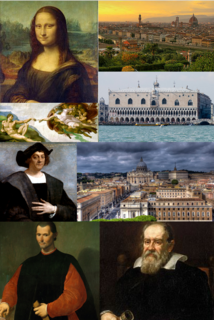 W
WThe Italian Renaissance was a period in the Italian history that covered the 15th (Quattrocento) and 16th (Cinquecento) centuries, spreading across Europe and marking the transition from the Middle Ages to Modernity. Proponents of a "long Renaissance" argue that it began in the 14th century (Trecento) and lasted until the 17th century (Seicento). The French word renaissance means "rebirth" and defines the period as one of cultural revival and renewed interest in classical antiquity after the centuries labeled the Dark Ages by Renaissance humanists. The Renaissance author Giorgio Vasari used the term "Rebirth" in his Lives of the Most Excellent Painters, Sculptors, and Architects in 1550 but the concept became widespread only in the 19th century, after the works of scholars such as Jules Michelet and Jacob Burckhardt.
 W
WThe Trecento refers to the 14th century in Italian cultural history.
 W
WThe cultural and artistic events of Italy during the period 1400 to 1499 are collectively referred to as the Quattrocento from the Italian word for the number 400, in turn from millequattrocento, which is Italian for the year 1400. The Quattrocento encompasses the artistic styles of the late Middle Ages, the early Renaissance, and the start of the High Renaissance, generally asserted to begin between 1495 and 1500.
 W
WThe cultural and artistic events of Italy during the period 1500 to 1599 are collectively referred to as the Cinquecento, from the Italian for the number 500, in turn from millecinquecento, which is Italian for the year 1500. Cinquecento encompasses the styles and events of the High Italian Renaissance, Mannerism and some early exponents of the Baroque-style.
 W
WItalian Renaissance painting is the painting of the period beginning in the late 13th century and flourishing from the early 15th to late 16th centuries, occurring in the Italian peninsula, which was at that time divided into many political states, some independent but others controlled by external powers. The painters of Renaissance Italy, although often attached to particular courts and with loyalties to particular towns, nonetheless wandered the length and breadth of Italy, often occupying a diplomatic status and disseminating artistic and philosophical ideas.
 W
WThe Aldine Press was the printing office started by Aldus Manutius in 1494 in Venice, from which were issued the celebrated Aldine editions of the classics. The first book that was dated and printed under his name appeared in 1495.
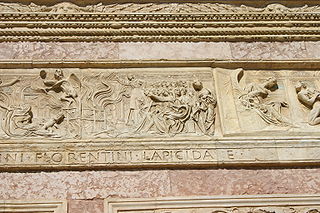 W
WA bonfire of the vanities is a burning of objects condemned by authorities as occasions of sin. The phrase usually refers to the bonfire of 7 February 1497, when supporters of Dominican friar Girolamo Savonarola collected and burned thousands of objects such as cosmetics, art, and books in Florence, Italy on the Shrove Tuesday festival.
 W
WThe Civilization of the Renaissance in Italy is an 1860 work on the Italian Renaissance by Swiss historian Jacob Burckhardt. Together with his History of the Renaissance in Italy it is counted among the classics of Renaissance historiography. An English translation was produced by S.G.C. Middlemore in two volumes, London 1878.
 W
WThe Cortile del Belvedere was a major architectural work of the High Renaissance at the Vatican Palace in Rome. Designed by Donato Bramante from 1505 onward, its concept and details reverberated in courtyard design, formalized piazzas and garden plans throughout Western Europe for centuries. Conceived as a single enclosed space, the long Belvedere court connected the Vatican Palace with the Villa Belvedere in a series of terraces connected by stairs, and was contained on its sides by narrow wings.
 W
WDe Viris Illustribus, meaning "concerning illustrious men", represents a genre of literature which evolved during the Italian Renaissance in imitation of the exemplary literature of Ancient Rome. It inspired the widespead commissioning of groups of matching portraits of famous men from history to serve as moral role models.
 W
WDuecento is the Italian word for the Italian culture during the 13th century.
 W
WThe Republic of Florence, officially the Florentine Republic, was a medieval and early modern state that was centered on the Italian city of Florence in Tuscany. The republic originated in 1115, when the Florentine people rebelled against the Margraviate of Tuscany upon the death of Matilda of Tuscany, who controlled vast territories that included Florence. The Florentines formed a commune in her successors' place. The republic was ruled by a council known as the Signoria of Florence. The signoria was chosen by the gonfaloniere, who was elected every two months by Florentine guild members.
 W
WFlorentine painting or the Florentine School refers to artists in, from, or influenced by the naturalistic style developed in Florence in the 14th century, largely through the efforts of Giotto di Bondone, and in the 15th century the leading school of Western painting. Some of the best known painters of the earlier Florentine School are Fra Angelico, Botticelli, Filippo Lippi, the Ghirlandaio family, Masolino, and Masaccio.
 W
WThe Forlivese school of art was a group of Italian Renaissance painters and other artists. Most were born in Forlì or near it in the Emilia-Romagna region of Italy. Some other artists went to Forlì to study.
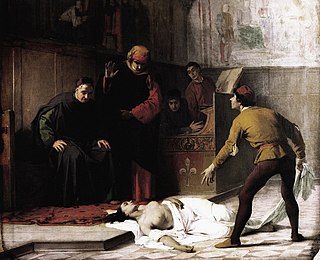 W
WThe Gonfalonier was the holder of a highly prestigious communal office in medieval and Renaissance Italy, notably in Florence and the Papal States. The name derives from gonfalone, the term used for the banners of such communes.
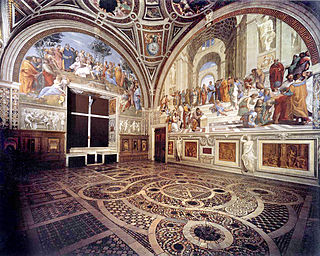 W
WIn art history, the High Renaissance is a short period of the most exceptional artistic production in the Italian states, particularly Rome, capital of the Papal States, and in Florence, during the Italian Renaissance. Most art historians state that the High Renaissance started around 1495 or 1500 and ended in 1520 with the death of Raphael, although some say the High Renaissance ended about 1525, or in 1527 with the Sack of Rome by the army of Charles V, Holy Roman Emperor, or about 1530. The best-known exponents of painting, sculpture and architecture of the High Renaissance include Leonardo da Vinci, Michelangelo and Raphael, and Bramante. In recent years, the use of the term has been frequently criticized by some academic art historians for oversimplifying artistic developments, ignoring historical context, and focusing only on a few iconic works.
 W
WThe Hours of Lorenzo de' Medici is a Renaissance book of Hours produced in Florence for Lorenzo de' Medici in the style of Francesco di Antonio del Chierico, the favourite miniature painter of Lorenzo's grandfather Cosimo de' Medici. It follows the Roman liturgy of the hours and contains illustrated calendars of saints and nine large miniatures with decorative borders.
 W
WThe Italian Renaissance garden was a new style of garden which emerged in the late 15th century at villas in Rome and Florence, inspired by classical ideals of order and beauty, and intended for the pleasure of the view of the garden and the landscape beyond, for contemplation, and for the enjoyment of the sights, sounds and smells of the garden itself.
 W
WThe Kingdom of Naples comprised the part of the Italian Peninsula south of the Papal States between 1282 and 1816. It was established by the War of the Sicilian Vespers (1282–1302), when the island of Sicily revolted and was conquered by the Crown of Aragon, becoming a separate kingdom also called the Kingdom of Sicily. In 1816, it reunified with the island of Sicily to form the Kingdom of the Two Sicilies.
 W
WThe Kingdom of Sicily was a state that existed in the south of the Italian peninsula and for a time the region of Ifriqiya from its founding by Roger II of Sicily in 1130 until 1816. It was a successor state of the County of Sicily, which had been founded in 1071 during the Norman conquest of the southern peninsula. The island was divided into three regions: Val di Mazara, Val Demone and Val di Noto; val being the apocopic form of the word vallo, derived from the Arabic word wilāya.
 W
WThe Libro de' Disegni was a collection of drawings gathered, sorted and grouped by Giorgio Vasari whilst writing his Lives of the Most Excellent Painters, Sculptors, and Architects. By the time of his death in 1574 it is thought to have contained around 526 drawings, of which 162 are now in the Louvre and 83 in the Nationalmuseum, Stockholm. There are also drawings from the Libro in the prints and drawings departments of the Uffizi, the British Museum, the Albertina, the National Gallery of Art and other institutions.
 W
WThe Treaty of Lodi, or Peace of Lodi, was a peace agreement between Milan, Naples and Florence that was signed on 9 April 1454 at Lodi in Lombardy, on the banks of the Adda. It put an end to the Wars in Lombardy between expansive Milan, under Filippo Maria Visconti, and Venice, in the terraferma. They had produced a single decisive Venetian victory, at the Battle of Maclodio in 1427 in which the Venetian ally was Florence but had resulted in no lasting peace. After a further generation of intermittent seasonal campaigning, the Treaty of Lodi established permanent boundaries between Milanese and Venetian territories in Northern Italy, along the river Adda. Francesco Sforza was confirmed as the rightful duke of Milan. A principle of a balance of power in Northern Italy was established, one that excluded ambitions of other powers: the Republic of Genoa, and the princely families of Savoy, Gonzaga and Este.
 W
WThe Monster of Ravenna was a possibly apocryphal late Renaissance-era monstrous birth whose appearance in early 1512 near the city of Ravenna was widely reported in contemporary European pamphlets and diaries. Images of its grotesque features were interpreted symbolically by opponents of both the Catholic Church and the Protestant Reformation, although a more common explanation at the time was that the beast was an omen regarding the outcome of the Battle of Ravenna (1512). Modern medical consensus identifies the monster as a child with some variety of severe congenital disorder.
 W
WParagone, was a debate from the Italian Renaissance in which painting and sculpture were each championed as superior to – and therefore distinct from – each other. While other art forms, such as architecture and poetry existed in the context of the debate, painting and sculpture were the two art forms that the debate was primarily focused on.
 W
WA plaquette is a small low relief sculpture in bronze or other materials. These were popular in the Italian Renaissance and later. They may be commemorative, but especially in the Renaissance and Mannerist periods were often made for purely decorative purposes, with often crowded scenes from religious, historical or mythological sources. Only one side is decorated, giving the main point of distinction with the artistic medal, where both sides are normally decorated. Most are rectangular or circular, but other shapes are found, as in the example illustrated. Typical sizes range from about two inches up to about seven across a side, or as the diameter, with the smaller end or middle of that range more common. They "typically fit within the hand", as Grove puts it. At the smaller end they overlap with medals, and at the larger they begin to be called plaques.
 W
WRelazioni were the final reports presented by Venetian ambassadors of their service in foreign states. Relazioni contained descriptions of the current political, military, economic, and social conditions of the country visited. Relazioni are important to historians for recording the development of diplomacy in early modern Europe.
 W
WThe Republic of Genoa was an independent state and maritime republic from the 11th century to 1797 in Liguria on the northwestern Italian coast, incorporating Corsica from 1347 to 1768, and numerous other territories throughout the Mediterranean and the Black Sea.
 W
WThe Republic of Lucca was a historic state of Italy, which lasted from 1160 to 1805 on the central Italian peninsula.
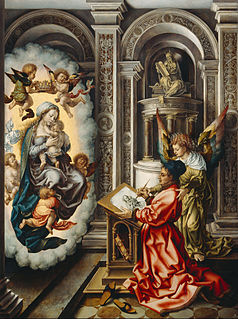 W
WRomanism is a term used by art historians to refer to painters from the Low Countries who had travelled in the 16th century to Rome. In Rome they had absorbed the influence of leading Italian artists of the period such as Michelangelo and Raphael and his pupils. Upon their return home, these Northern artists created a Renaissance style, which assimilated Italian formal language. The style continued its influence until the early 17th century when it was swept aside by the Baroque.
 W
WIn art, a sacra conversazione, meaning holy conversation, is a genre developed in Italian Renaissance painting, with a depiction of the Virgin and Child amidst a group of saints in a relatively informal grouping, as opposed to the more rigid and hierarchical compositions of earlier periods. Donor portraits may also be included, generally kneeling, often their patron saint is presenting them to the Virgin, and angels are frequently in attendance.
 W
WThe Signoria was the government of the medieval and Renaissance Republic of Florence, between 1250 and 1532. Its nine members, the Priori, were chosen from the ranks of the guilds of the city: six of them from the major guilds, and two from the minor guilds. The ninth became the Gonfaloniere of Justice.
 W
WStipo a bambocci is a writing cabinet, which was made during the Renaissance in Upper Italy and which can be locked by a fall-front.
 W
WThe tarot is a pack of playing cards, used from the mid-15th century in various parts of Europe to play games such as Italian tarocchini, French tarot and Austrian Königrufen, many of which are still played today. In the late 18th century, some tarot decks began to be used for divination via tarot card reading and cartomancy leading to custom decks developed for such occult purposes.
 W
WThis article about the development of themes in Italian Renaissance painting is an extension to the article Italian Renaissance painting, for which it provides additional pictures with commentary. The works encompassed are from Giotto in the early 14th century to Michelangelo's Last Judgement of the 1530s.
 W
WA tondo is a Renaissance term for a circular work of art, either a painting or a sculpture. The word derives from the Italian rotondo, "round." The term is usually not used in English for small round paintings, but only those over about 60 cm in diameter, thus excluding many round portrait miniatures – for sculpture the threshold is rather lower.
 W
WThe Venetian polychoral style was a type of music of the late Renaissance and early Baroque eras which involved spatially separate choirs singing in alternation. It represented a major stylistic shift from the prevailing polyphonic writing of the middle Renaissance, and was one of the major stylistic developments which led directly to the formation of what is now known as the Baroque style. A commonly encountered term for the separated choirs is cori spezzati—literally, separated choirs.